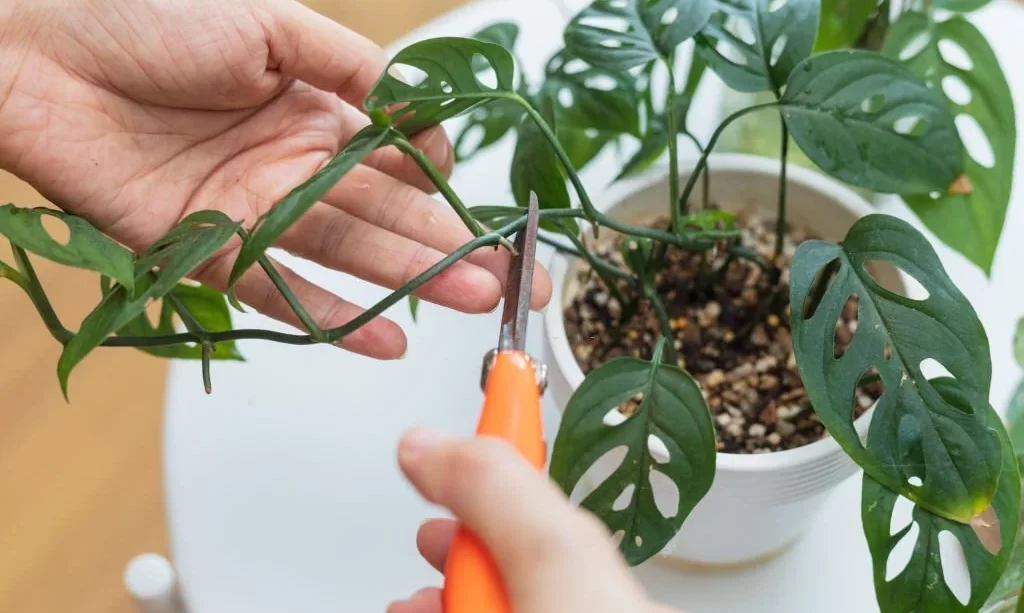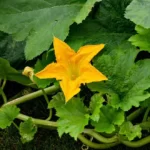If you’re a plant enthusiast, you’ve likely come across the Monstera plant, a true icon of the indoor gardening world. With its distinctive split leaves and graceful vines, the Monstera has earned a special place in the hearts of plant lovers. However, to keep this tropical beauty thriving and looking its best, regular trimming is key. In this guide, we’ll walk you through the art of trimming a Monstera plant, ensuring that you can care for it like a pro. Whether you’re a seasoned green thumb or just starting your plant journey, mastering the art of trimming will help you maintain a healthy and visually stunning Monstera.
- MAKE PRUNING WORK EASIER: Rust-resistant stainless steel blade are sharp and durable for easy and smooth cut.Anti-slip and ergonomic handle make the gardener clippers more comfortable in your hand.Easy-open spring action reduces hand fatigue while cutting. you can easily to cut without damaging the vital stems and branches of your plants.
- User-FRIENDLY SAFETY LOCK:These garden shears have locking mechanisms to keep the sharp blades securely closed when not in use.It is easy to maneuver and can effectively reduce accidental injuries.
- GARDEN GLOVES: This Gardening gloves,made of soft & comfortable cotton fabric,can protect yourself from dirt, skin wounds and nasty splinters when doing yard chores. The grip latex coating provides anti-slip or sure control when grabbing garden & yard tools.
- COMFORTABLE HANDLE: The handle part of the pruning shears made by high-purity PP+TPR plastic, especially the hand grip is very comfortable, but also has strong toughness and strength.
- PACKING LISTING: The packing include pruning shear, fruits shear, flower cutter, leaves trimmer, one pair glove, one organizer bag.Those pruning shears could satisfy need of planting, harvesting, floral, indoor and outdoor planting, greenhouse pruning.
Monstera
Before we dive into the trimming process, it’s essential to get to know your Monstera plant better. Monstera, scientifically known as Monstera deliciosa, is characterized by its striking foliage. Its large, heart-shaped leaves feature distinctive splits and holes, giving it the nickname “Swiss Cheese Plant”.
Understanding your Monstera’s growth habits is crucial. These plants are natural climbers, and in their native habitat, they use aerial roots to cling to trees and reach for sunlight. When cultivated indoors, Monstera plants can still exhibit these climbing tendencies, often producing long vines that need some direction.
Trimming your Monstera serves several purposes. First, it encourages the plant to branch out, creating a bushier appearance. Second, it helps remove damaged or yellowing leaves, keeping the plant’s overall health in check. Lastly, trimming can help manage the size of your Monstera, ensuring it fits well within its indoor environment.
As you embark on your journey to trim your Monstera, keep these growth patterns and objectives in mind. Armed with this knowledge, you’ll be better prepared to shape and care for your plant effectively.
- Please Read: We do not ship to California, Alaska, or Hawaii. Thank you!
- Bloom Time: Tropical Foliage Plant; Watering: Moderately moist soil
- Environment: Monstera Deliciosa Swiss Cheese plant does best in partial sun exposure.
- USDA Plant Hardiness Zone: 32°F, 10 to 11
- Overall Size: 30 inches to 36 inches tall including the 10inch planter.
Gather Your Tools
Before you embark on the journey of trimming your Monstera, it’s essential to have the right tools at your disposal. Gathering the necessary equipment will make the process smoother and help you achieve clean, precise cuts. Here’s a list of tools and materials you’ll need:
- Sharp Scissors or Pruning Shears: Opt for clean and sharp cutting tools to prevent tearing or damaging the plant’s tissues.
- Gloves: Invest in a good pair of gardening gloves to protect your hands from potential skin irritation and sap.
- Clean Cloth or Paper Towels: Keep a clean cloth or paper towels handy to wipe your tools between cuts. This helps prevent the spread of pests or diseases.
By having these tools ready, you’ll be well-prepared to trim your Monstera effectively and with care.
Identifying Areas for Trimming
Trimming your Monstera isn’t about randomly snipping away leaves and vines; it’s a precise process that targets specific areas. Here’s how to identify the parts that may need trimming:
- Yellowing or Brown Leaves: Check your Monstera for any leaves that have turned yellow or brown. These are usually older leaves that have reached the end of their life cycle and can be safely trimmed away.
- Damaged or Diseased Foliage: Look for leaves with visible damage, such as holes, spots, or signs of disease. Trimming these leaves helps maintain the overall health of your plant.
- Overgrown Vines: If your Monstera has long, leggy vines that are getting unruly, you can trim them to encourage a more compact and bushy growth habit. Focus on the longest and most out-of-control vines.
Identifying these areas for trimming ensures that you’re making thoughtful and beneficial cuts to your Monstera plant.
The Trimming Process
Now, let’s dive into the step-by-step process of trimming your Monstera:
- Prepare Your Workspace: Find a clean, well-lit area where you can work comfortably. Lay out your tools and have a clean cloth or paper towels nearby.
- Inspect the Plant: Carefully examine your Monstera, identifying the areas you’ve determined need trimming based on the criteria mentioned earlier.
- Make Clean Cuts: With your sharp scissors or pruning shears, make clean and precise cuts just above a leaf node. A leaf node is a small bump or nub where a leaf or vine branches off from the main stem. Cutting just above a node encourages new growth.
- Dispose of Trimmed Material: After each cut, use your cloth or paper towels to wipe your tools clean to prevent the spread of any potential diseases. Dispose of the trimmed leaves and vines.
- Monitor Your Progress: Step back and assess the plant’s appearance as you trim. Aim for a balanced and aesthetically pleasing shape. Avoid over-trimming, which can stress the plant.
- Water and Care: After trimming, give your Monstera a thorough watering to help it recover. Ensure it receives proper light and humidity to support its growth.
By following these steps, you’ll be well on your way to successfully trimming your Monstera and helping it thrive in its indoor environment.
Aftercare and Maintenance
Once you’ve completed the trimming process, your Monstera deserves some post-trim care and ongoing maintenance. Here’s how to ensure your plant remains healthy and vibrant:
- Tool Maintenance: After using your scissors or pruning shears, clean them thoroughly and store them properly. This prevents the transfer of diseases or pests between plants.
- Fertilization: Consider feeding your Monstera with a balanced, water-soluble fertilizer during the growing season. Follow the manufacturer’s instructions for application.
- Watering: Continue to water your Monstera appropriately, allowing the top inch of soil to dry between waterings. Adjust the frequency based on your specific indoor conditions.
- Light and Humidity: Ensure your Monstera receives the right amount of indirect sunlight. Bright, filtered light is ideal. If the air in your home is dry, consider increasing humidity levels around the plant, as Monstera thrives in humid conditions.
- Monitor for Pests and Diseases: Regularly inspect your Monstera for signs of pests like spider mites or mealybugs. Address any issues promptly with natural pest control methods or insecticidal soap.
- Tailored Nutrient Blend: Our indoor houseplant fertilizer is formulated with a precisely balanced blend of nutrients, ensuring your plants receive the specific nourishment they need for robust growth and vibrant foliage.
- Optimal Absorption: The unique liquid formulation is designed for efficient nutrient absorption, delivering essential elements directly to the roots and leaves, resulting in quicker and more noticeable plant health improvements.
- Indoor Environment Focus: Developed with indoor plants in mind, our fertilizer takes into account the specific conditions of indoor settings, providing nutrients that cater to the controlled environment of your home.
- Enhanced Growth Patterns: Our fertilizer encourages and supports growth patterns that are well-suited to indoor spaces, helping your plants thrive without excessive stretching or sprawling.
- Mess-Free Application: Applying our specially crafted fertilizer is simple and mess-free, with easy-to-follow instructions. No more worrying about soil spills or residue on your indoor surfaces.
Propagation Tips
If you want to take your Monstera care to the next level, you can explore propagation, a way to grow new plants from your trimmed cuttings. Here’s a simplified guide to propagation:
- Select Healthy Cuttings: Choose a healthy vine section with a few nodes (the small bumps where leaves and roots grow). Cut just below a node.
- Rooting Medium: Plant the cutting in a well-draining potting mix or a mix of perlite and peat moss. Water it lightly and place it in a warm, humid environment.
- Root Development: Over time, the cutting will develop roots. Keep the soil consistently moist but not waterlogged.
- Transplanting: Once the cutting has a good root system, transplant it into a larger pot with standard potting soil.
Propagation can be a rewarding way to expand your Monstera collection or share plants with friends and family.
Conclusion
Trimming your Monstera isn’t just about maintaining its appearance; it’s about promoting its health and vitality. By understanding your Monstera’s growth habits, gathering the right tools, and identifying areas for trimming, you can ensure your plant continues to thrive. The trimming process itself involves making clean cuts, monitoring your progress, and providing proper care afterward.
Remember that a well-maintained Monstera is not only visually appealing but also contributes to a healthier indoor environment. With regular care, your Monstera will continue to grace your living space with its iconic split leaves and lush greenery, making it a beautiful addition to your home. So, don’t be afraid to give your Monstera a little trim—it’s all part of the journey of nurturing these incredible tropical plants.






